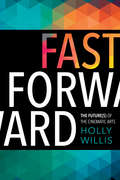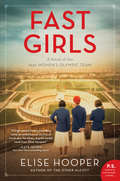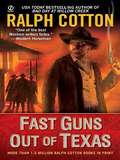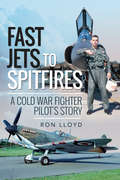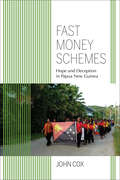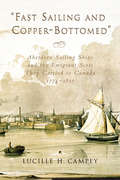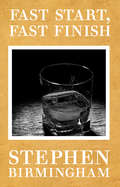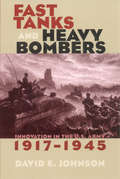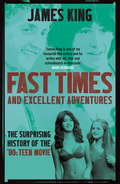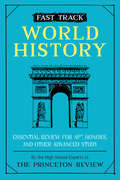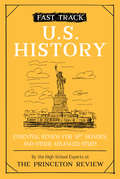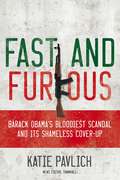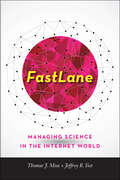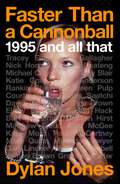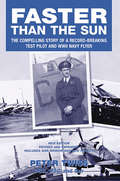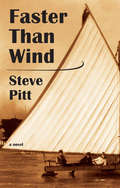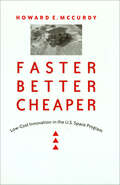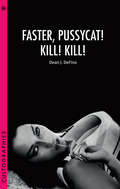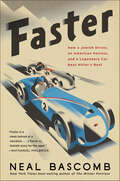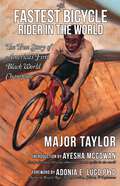- Table View
- List View
Fast Forward: The Future(s) of the Cinematic Arts
by Holly WillisCinema, the primary vehicle for storytelling in the twentieth century, is being reconfigured y new media in the twenty-first. Terms such as "worldbuilding," "virtual reality," and "transmedia" introduce new methods for constructing a screenplay and experiencing and sharing a story. Similarly, 3D cinematography, hypercinema, and visual effects require different modes for composing an image, and virtual technology, motion capture, and previsualization completely rearrange the traditional flow of cinematic production. What does this mean for telling stories? Fast Forward answers this question by investigating a full range of contemporary creative practices dedicated to the future of mediated storytelling and by connecting with a new generation of filmmakers, screenwriters, technologists, media artists, and designers to discover how they work now, and toward what end. From Chris Milk and Aaron Koblin's exploration of VR spherical filmmaking to Rebeca Méndez's projection and installation work exploring climate change to the richly mediated interactive live performances of the collective Cloud Eye Control, this volume captures a moment of creative evolution and sets the stage for imagining the future of the cinematic arts.
Fast Forward: The Future(s) of the Cinematic Arts
by Holly WillisCinema, the primary vehicle for storytelling in the twentieth century, is being reconfigured by new media in the twenty-first. Terms such as "worldbuilding," "virtual reality," and "transmedia" introduce new methods for constructing a screenplay and experiencing and sharing a story. Similarly, 3D cinematography, hypercinema, and visual effects require different modes for composing an image, and virtual technology, motion capture, and previsualization completely rearrange the traditional flow of cinematic production. What does this mean for telling stories? Fast Forward answers this question by investigating a full range of contemporary creative practices dedicated to the future of mediated storytelling and by connecting with a new generation of filmmakers, screenwriters, technologists, media artists, and designers to discover how they work now, and toward what end. From Chris Milk and Aaron Koblin's exploration of VR spherical filmmaking to Rebeca Méndez's projection and installation work exploring climate change to the richly mediated interactive live performances of the collective Cloud Eye Control, this volume captures a moment of creative evolution and sets the stage for imagining the future of the cinematic arts.
Fast Girls: A Novel of the 1936 Women's Olympic Team
by Elise Hooper“Fast Girls is a compelling, thrilling look at what it takes to be a female Olympian in pre-war America...Brava to Elise Hooper for bringing these inspiring heroines to the wide audience they so richly deserve.”—Tara Conklin, New York Times bestselling author of The Last Romantics and The House Girl Acclaimed author Elise Hooper explores the gripping, real life history of female athletes, members of the first integrated women’s Olympic team, and their journeys to the 1936 summer games in Berlin, Nazi Germany. Perfect for readers who love untold stories of amazing women, such as The Only Woman in the Room, Hidden Figures, and The Lost Girls of Paris. In the 1928 Olympics, Chicago’s Betty Robinson competes as a member of the first-ever women’s delegation in track and field. Destined for further glory, she returns home feted as America’s Golden Girl until a nearly-fatal airplane crash threatens to end everything. Outside of Boston, Louise Stokes, one of the few black girls in her town, sees competing as an opportunity to overcome the limitations placed on her. Eager to prove that she has what it takes to be a champion, she risks everything to join the Olympic team. From Missouri, Helen Stephens, awkward, tomboyish, and poor, is considered an outcast by her schoolmates, but she dreams of escaping the hardships of her farm life through athletic success. Her aspirations appear impossible until a chance encounter changes her life. These three athletes will join with others to defy society’s expectations of what women can achieve. As tensions bring the United States and Europe closer and closer to the brink of war, Betty, Louise, and Helen must fight for the chance to compete as the fastest women in the world amidst the pomp and pageantry of the Nazi-sponsored 1936 Olympics in Berlin.
Fast Guns Out Of Texas
by Ralph CottonCray Dawson is en route to Black's Cut in Montana to stake his claim when he learns his old friend Fast Larry Shaw faked his death to escape his notoriety as a gunfighter. But Dawson discovers that his own prowess with firearms haunts him too.
Fast Jets to Spitfires: A Cold War Fighter Pilot's Story
by Ron LloydA memoir of RAF service in the postwar era and the golden age of British military aviation, including photos.How often have you glanced skyward at the sound of a passing aircraft and wondered what it would be like to fly one of those gleaming metal machines? Or admired the skill and daring of the fighter pilot swooping down upon his enemy in the awe-inspiring, unrivaled elegance of a Spitfire? Ron Lloyd has had the experience of flying the majestic propeller-driven aircraft of the Second World War as well as the roaring, sound-barrier-breaking jets of the Cold War—and in this exciting book, he places the reader in the cockpit, describing what it really feels like to be sitting at the controls of a fighter aircraft.Lloyd joined the RAF after World War II, and during his early service he was selected as one of the pilots to fly the wartime aircraft in the feature film The Battle of Britain, giving him the opportunity to fly a Spitfire and even a Messerschmitt Bf 109 during the six weeks of filming. His role with the RAF, on the other hand, saw him on the front line in the Cold War, piloting de Havilland Vampires, Hawker Hunters, Gloster Javelins, Lightnings, and Phantoms. He also served on exchange in the USA where he flew Convair F-102s, Convair F-106s, and Lockheed T-33s.Packed with unique photographs of the golden age of British military aviation, Fast Jets to Spitfires allows readers to experience, through Ron Lloyd’s graphic accounts, the pure joy of being airborne.
Fast Money Schemes: Hope and Deception in Papua New Guinea (Framing the Global)
by John CoxA history and anthropological analysis of one of Papua New Guinea’s worst Ponzi schemes in the late 1990s.In the late 1990s and early 2000s a wave of Ponzi schemes swept through Papua New Guinea, Australia, and the Solomon Islands. The most notorious scheme, U-Vistract, attracted many thousands of investors, enticing them with promises of one percent interest to be paid monthly. Its founder, Noah Musingku, was a charismatic leader who promoted the scheme as a form of Christian mission and as the basis for establishing an independent kingdom.Fast Money Schemes uses in-depth interviews with investors, newspaper accounts, and participant observation to understand the scheme’s appeal from the point of view of those who invested and lost, showing that organizers and investors alike understood the scheme as a way of accessing and participating in a global economy. John Cox delivers a “post-village” ethnography that gives insight into the lives of urban, middle-class Papua New Guineans, a group that is not familiar to US readers and that has seldom been a focus of anthropological interest. The book’s concern with understanding the interweaving of morality, finance, and aspirations shared by a global cosmopolitan middle class has wide resonance beyond studies of Papua New Guinea and anthropology.
Fast Sailing and Copper-Bottomed: Aberdeen Sailing Ships and the Emigrant Scots They Carried to Canada, 1774-1855
by Lucille H. CampeyThe days when Aberdeen’s "fast sailing and copper-bottomed" ships carried emigrant Scots to Canada are brought to life in this fascinating account of the northern Scotland exodus during the sailing ship era. Taking readers through new and little-used documentary sources, Lucille H. Campey finds convincing evidence of good ships, sailed by experienced captains and managed by reputable people, thus challenging head on the perceived imagery of abominable sea passages in leaking old tubs. And by considering the significance of ship design and size, she opens a new window on our understanding of emigrant travel. Instead of concentrating on the extreme cases of suffering and mishaps, to be found in anecdotal material, Campey’s approach is to identify all of the emigrant sea crossings to Canada made on Aberdeen sailing ships.Observing the ships which collected passengers from the port of Aberdeen as well as those which collected emigrants at Highland ports, especially Cromarty and Thurso, Campey reveals the processes at work and the people who worked behind the scenes to provide the services. Her following of the emigrant Scots on to their New World destinations in New Brunswick, Nova Scotia and Upper Canada provides us with an opportunity to see how events in Canada were influencing both the decision to emigrate and choice of location. These emigrant Scots succeeded, often after difficult beginnings, and would endow Canada with their rich traditions and culture which live on to this day.
Fast Start, Fast Finish
by Stephen BirminghamFast Start, Fast Finish is a novel of suspense, art, marriage, family, and the hollowness of suburbia, from one the country's most important documentarians of the well-to-do. Charlie Lord is handsome, smart and devastatingly sophisticated. Why does his life keep coming to a blazing halt?
Fast Tanks and Heavy Bombers: Innovation in the U.S. Army, 1917–1945 (Cornell Studies in Security Affairs)
by David E. JohnsonThe U. S. Army entered World War II unprepared. In addition, lacking Germany's blitzkrieg approach of coordinated armor and air power, the army was organized to fight two wars: one on the ground and one in the air. Previous commentators have blamed Congressional funding and public apathy for the army's unprepared state. David E. Johnson believes instead that the principal causes were internal: army culture and bureaucracy, and their combined impact on the development of weapons and doctrine. Johnson examines the U. S. Army's innovations for both armor and aviation between the world wars, arguing that the tank became a captive of the conservative infantry and cavalry branches, while the airplane's development was channeled by air power insurgents bent on creating an independent air force. He maintains that as a consequence, the tank's potential was hindered by the traditional arms, while air power advocates focused mainly on proving the decisiveness of strategic bombing, neglecting the mission of tactical support for ground troops. Minimal interaction between ground and air officers resulted in insufficient cooperation between armored forces and air forces. Fast Tanks and Heavy Bombers makes a major contribution to a new understanding of both the creation of the modern U. S. Army and the Army's performance in World War II. The book also provides important insights for future military innovation.
Fast Times and Excellent Adventures: The Surprising History of the '80s Teen Movie
by James King'Brilliant' Mail on SundayTake a trip back to the era of troubled teens and awesome soundtracks; of Reagan, rap and Ridgemont High; of MTV, VHS and 'Axel F'; of outsiders, lost boys and dead poets; of Bill and Ted, Brooke Shields and the Brat Pack; of three Porky's, two Coreys and one summer when everyone called her Baby . . . Fast Times and Excellent Adventures goes behind the scenes of a genre where cult hits mingled with studio blockbusters, where giants like Spielberg and Coppola rubbed shoulders with baby-faced first-timers and where ambitious future superstars Sean, Demi and Tom all got their big break. Music, comedy and politics - all play a part in the surprisingly complex history of the '80s teen movie. And while the films might have been aimed primarily at adolescents, the best tackle universal issues and remain a magnet to all ages. Time of your life, huh kid?From a late '70s Hollywood in flux to an early '90s indie scene that gave youth cinema a timely reboot, respected film expert James King smartly highlights the personal struggles, the social changes and the boardroom shake-ups that produced an iconic time in movie history.
Fast Times and Excellent Adventures: The Surprising History of the '80s Teen Movie
by James King'Brilliant' Mail on SundayTake a trip back to the era of troubled teens and awesome soundtracks; of Reagan, rap and Ridgemont High; of MTV, VHS and 'Axel F'; of outsiders, lost boys and dead poets; of Bill and Ted, Brooke Shields and the Brat Pack; of three Porky's, two Coreys and one summer when everyone called her Baby . . . Fast Times and Excellent Adventures goes behind the scenes of a genre where cult hits mingled with studio blockbusters, where giants like Spielberg and Coppola rubbed shoulders with baby-faced first-timers and where ambitious future superstars Sean, Demi and Tom all got their big break. Music, comedy and politics - all play a part in the surprisingly complex history of the '80s teen movie. And while the films might have been aimed primarily at adolescents, the best tackle universal issues and remain a magnet to all ages. Time of your life, huh kid?From a late '70s Hollywood in flux to an early '90s indie scene that gave youth cinema a timely reboot, respected film expert James King smartly highlights the personal struggles, the social changes and the boardroom shake-ups that produced an iconic time in movie history.
Fast Track to A 5: Preparing for the AP United States History Examination
by Mark EpsteinA preparation guide for students taking the AP United States history examination with an introductory strategy section, diagnostic test, and document-based questions for practice.
Fast Track: Essential Review for AP, Honors, and Other Advanced Study (High School Subject Review)
by The Princeton ReviewGET UP TO SPEED WITH FAST TRACK: WORLD HISTORY! Covering the most important material taught in high school history class, this essential review book breaks need-to-know content into accessible, easily-understood lessons.Inside this book, you'll find:• Clear, concise summaries of the most important events, people and concepts in world history• Maps, timelines, and charts for quick visual reference• Easy-to-follow content organization and illustrationsWith its friendly, straightforward approach and a clean, modern design crafted to appeal to visual learners, this guidebook is perfect for catching up in class or getting ahead on exam review.Topics covered in Fast Track: World History include:• The Paleolithic era• Early and Classical civilizations• The Byzantine Empire• China, Japan, and India• The Renaissance• The Enlightenment• American and French Revolutions• Imperialism• Colonialism• World Wars I and II• The Cold War• Globalization... and more!
Fast Track: Essential Review for AP, Honors, and Other Advanced Study (High School Subject Review)
by The Princeton ReviewGET UP TO SPEED WITH FAST TRACK: U.S. History! Covering the most important material taught in high school American history class, this essential review book breaks need-to-know content into accessible, easily understood lessons.Inside this book, you'll find:• Clear, concise summaries of the most important events, people, and concepts in United States history• Maps, timelines, and charts for quick visual reference• Easy-to-follow content organization and illustrationsWith its friendly, straightforward approach and a clean, modern design crafted to appeal to visual learners, this guidebook is perfect for catching up in class or getting ahead on exam review.Topics covered in Fast Track: U.S. History include:• Native Americans• Colonial America• The Revolutionary War• Abolitionism and suffrage• The Civil War and Reconstruction• The Industrial Revolution• The Great Depression• World Wars I and II• The Cold War• Civil rights• Conservatism and the "New Right"• 9/11 and globalism... and more!
Fast and Furious: Barack Obama's Bloodiest Scandal and Its Shameless Cover-up
by Katie PavlichA BLOODY SCANDAL AND ITS SHAMELESS COVER-UP. No scandal is more threatening to the Obama administration than Operation Fast and Furious. While other scandals involve money, Fast and Furious involves lives, including that of Border Patrol Agent Brian Terry, gunned down with a weapon that the federal government put in the hands of Mexico's narco-terrorists. As shocking as Operation Fast and Furious was--and this book explains, in chilling detail, just what this operation conducted by the ATF, under the supervision of the Justice Department, entailed--equally appalling is the blatant cover-up of wrongdoing by the Obama administration. No reporter has been more dogged in tracking down the facts about Fast and Furious than Katie Pavlich. In her stunning new book she reveals: » The documents that undermine the White House's claims of ignorance about Fast and Furious "How Eric Holder, President Obama's attorney general, has, under oath, repeatedly changed his testimony » The still mounting death toll from Fast and Furious "The retaliation against Fast and Furious whistleblowers "Why Homeland Security Secretary Janet Napolitano might be charged with perjury » The Obama administration's continuing assault on Second Amendment rights » Why Fast and Furious could be a bigger scandal than Watergate Unraveling the mystery of what Fast and Furious was all about, Katie Pavlich delivers a stunning indictment of a radical administration willing to trample the Constitution and risk lives to achieve its ideological goals.
FastLane: Managing Science in the Internet World (Johns Hopkins Studies in the History of Technology)
by Thomas J. Misa Jeffrey R. YostThe unique history and development of FastLane, the central nervous system of the National Science Foundation.Since 2000, the National Science Foundation has depended upon its pioneering FastLane e-government system to manage grant applications, peer reviews, and reporting. In this behind-the-scenes account Thomas J. Misa and Jeffrey R. Yost examine how powerful forces of science and computing came together to create this influential grant-management system, assessing its impact on cutting-edge scientific research.Why did the NSF create FastLane, and how did it anticipate the development of web-based e-commerce? What technical challenges did the glitch-prone early system present? Did the switch to electronic grant proposals disadvantage universities with fewer resources? And how did the scientific community help shape FastLane? Foregrounding the experience of computer users, the book draws on hundreds of interviews with scientific researchers, sponsored project administrators, NSF staff, and software designers, developers, and managers.
Faster Than A Cannonball: 1995 and All That
by Dylan JonesDecades tend to crest halfway through, and 1995 was the year of the Nineties: peak Britpop (Oasis v Blur), peak YBA (Tracey Emin's tent), peak New Lad (when Nick Hornby published High Fidelity, when James Brown's Loaded detonated the publishing industry, and when pubs were finally allowed to stay open on a Sunday). It was the year of The Bends, the year Danny Boyle started filming Trainspotting, the year Richey Edwards went missing, the year Alex Garland wrote The Beach, the year Blair changed Clause IV after a controversial vote at the Labour Conference. Not only was the mid-Nineties perhaps the last time that rock stars, music journalists and pop consumers held onto a belief in rock's mystical power, it was a period of huge cultural upheaval - in art, literature, publishing and drugs. And it was a period of almost unparalleled hedonism, a time when many people thought they deserved to live the rock and roll lifestyle, when a generation of narcotic omnivores thought they could all be rock stars just by buying a magazine and a copy of (What's the Story) Morning Glory? Faster Than a Cannonball is a cultural swipe of the decade from loungecore to the rise of New Labour, teasing all the relevant artistic strands through interviews with all the major protagonists and exhaustive re-evaluations of the important records of the year - The Bends by Radiohead, Grand Prix by Teenage Fanclub, Maxinquaye by Tricky, Different Class by Pulp, The Great Escape by Blur, It's Great When You're Straight... Yeah! by Black Grape, Exit Planet Dust by the Chemical Brothers, I Should Coco by Supergrass, Elastica by Elastica, Pure Phase by Spiritualized, ...I Care Because You Do by Aphex Twin and of course (What's the Story) Morning Glory by Oasis, the most iconic album of the decade.
Faster Than A Cannonball: 1995 and All That
by Dylan JonesDecades tend to crest halfway through, and 1995 was the year of the Nineties: peak Britpop (Oasis v Blur), peak YBA (Tracey Emin's tent), peak New Lad (when Nick Hornby published High Fidelity, when James Brown's Loaded detonated the publishing industry, and when pubs were finally allowed to stay open on a Sunday). It was the year of The Bends, the year Danny Boyle started filming Trainspotting, the year Richey Edwards went missing, the year Alex Garland wrote The Beach, the year Blair changed Clause IV after a controversial vote at the Labour Conference. Not only was the mid-Nineties perhaps the last time that rock stars, music journalists and pop consumers held onto a belief in rock's mystical power, it was a period of huge cultural upheaval - in art, literature, publishing and drugs. And it was a period of almost unparalleled hedonism, a time when many people thought they deserved to live the rock and roll lifestyle, when a generation of narcotic omnivores thought they could all be rock stars just by buying a magazine and a copy of (What's the Story) Morning Glory? Faster Than a Cannonball is a cultural swipe of the decade from loungecore to the rise of New Labour, teasing all the relevant artistic strands through interviews with all the major protagonists and exhaustive re-evaluations of the important records of the year - The Bends by Radiohead, Grand Prix by Teenage Fanclub, Maxinquaye by Tricky, Different Class by Pulp, The Great Escape by Blur, It's Great When You're Straight... Yeah! by Black Grape, Exit Planet Dust by the Chemical Brothers, I Should Coco by Supergrass, Elastica by Elastica, Pure Phase by Spiritualized, ...I Care Because You Do by Aphex Twin and of course (What's the Story) Morning Glory by Oasis, the most iconic album of the decade.
Faster Than The Sun: The Compelling Story of a Record-Breaking Test Pilot and WWII Navy Flyer
by Peter TwissThe autobiography of the Fairey Aviation test pilot and Naval fighter pilot who broke the World Air Speed Record in 1956. This autobiography of Peter Twiss, the man who flew 1000mph for the first time in history, tells the story of the record-breaking Fairey Delta. It describes the vast organization necessary for the record bid, the political lobbying, and the almost intolerable tension when the flights failed.Faster Than the Sun is also a compelling account of Twiss&’s wartime experiences as a Fleet Air Arm pilot who saw action in Fulmars over the convoys to Malta, in Seafires during the Operation Torch landings in Africa, and as a night fighter flying Mosquitoes. It is an epic account of daring, determination, and dedication—straight from the cockpit.
Faster Than Wind
by Steve PittShort-listed for the Manitoba Young Reader’s Choice Award, 2010 It is 1900, and 14-year-old Bertie McCross is a newspaper boy in downtown Toronto. Berties family has fallen on hard times and can use every penny he brings home from hawking newspapers on the frigid streets. However, in order to do that Bertie has to keep out of the clutches of the Kelly Gang, a family of slightly older Cabbagetown toughs who are shaking down "newsies." On Christmas Eve, Bertie is almost cornered by the Kellys but is saved by Tommy Fry and Milwaukee Ed, who introduce Bertie to the thrills of iceboat racing on Lake Ontario. Soon Bertie is swept up in the fast and dangerous sport and meets a whole crew of new friends, including Isobel, a girl from a wealthy family with a mansion on Jarvis Street. The continued pursuit by the Kelly Gang, a plunge into freezing harbour water, and the clash of classes all lead up to a spine-tingling race to end all races.
Faster, Better, Cheaper: Low-Cost Innovation in the U.S. Space Program (New Series in NASA History)
by Howard E. McCurdyIn Faster, Better, Cheaper: Low-Cost Innovation in the U.S. Space Program, Howard E. McCurdy examines NASA's recent efforts to save money while improving mission frequency and performance. McCurdy details the sixteen missions undertaken during the 1990s—including an orbit of the moon, deployment of three space telescopes, four Earth-orbiting satellites, two rendezvous with comets and asteroids, and a test of an ion propulsion engine—which cost less than the sum traditionally spent on a single, conventionally planned planetary mission. He shows how these missions employed smaller spacecraft and cheaper technology to undertake less complex and more specific tasks in outer space. While the technological innovation and space exploration approach that McCurdy describes is still controversial, the historical perspective on its disappointments and triumphs points to ways of developing "faster, better, and cheaper" as a management manifesto.
Faster, Better, Cheaper: Low-Cost Innovation in the U.S. Space Program (New Series in NASA History)
by Howard E. McCurdy&“This excellent summary of an important part of NASA&’s history is recommended for all readers.&” —Choice In Faster, Better, Cheaper: Low-Cost Innovation in the U.S. Space Program, Howard E. McCurdy examines NASA&’s recent efforts to save money while improving mission frequency and performance. McCurdy details sixteen missions undertaken as the twentieth century drew to a close—including an orbit of the moon, deployment of three space telescopes, four Earth-orbiting satellites, two rendezvous with comets and asteroids, and a test of an ion propulsion engine—which cost less than the sum traditionally spent on a single, conventionally planned planetary mission. He shows how these missions employed smaller spacecraft and cheaper technology to undertake less complex and more specific tasks in outer space. While the technological innovation and space exploration approach that McCurdy describes is still controversial, the historical perspective on its disappointments and triumphs points to ways of developing &“faster, better, and cheaper&” as a management manifesto. &“Readers interested in either the management or economics of complex organizations will find a wealth of material in this well-written exposition. Fans of space travel, like the author himself, will also enjoy the behind-the-scenes look at NASA&’s operation.&” —Enterprise and Society
Faster, Pussycat! Kill! Kill! (Cultographies)
by Dean DeFinoRuss Meyer's Faster, Pussycat! Kill! Kill! (1965) is an enigma. A box-office failure when initially released on the grindhouse circuit, it has since been embraced by art-house audiences, and referenced in countless films, television series, and songs. A riot of styles and story clichés lifted from biker, juvenile delinquency, and beach party movies, it has the coherence of a dream, and the improvisatory daring of a jazz solo. John Waters has called it the greatest movie ever made, and Quentin Tarantino has long promised to remake it. But what draws them, and so many other cult fans to Pussycat? To help answer that question, this book looks at the production and critical reception of the film, its place within the cultural history of the 1960s, its representations of gender and sexuality, and the specific ways it meets the criteria of a cult film.
Faster: How a Jewish Driver, an American Heiress, and a Legendary Car Beat Hitler's Best
by Neal BascombThe New York Times bestselling author thrillingly recounts how an underdog driving team beat Hitler’s fearsome Silver Arrows in the 1938 Pau Grand Prix. They were the unlikeliest of heroes. Rene Dreyfus, a former top driver on the international racecar circuit, had been banned from the best European teams—and fastest cars—by the mid-1930s because of his Jewish heritage. Charles Weiffenbach, head of the down-on-its-luck automaker Delahaye, was desperately trying to save his company. And Lucy Schell, the adventurous daughter of an American multi-millionaire, yearned to reclaim the glory of her rally-driving days. As Nazi Germany pushed the world toward war, these three misfits banded together to challenge Hitler’s dominance at the apex of motorsport: the Grand Prix. Their quest for redemption culminated in a remarkable race that is still talked about in racing circles to this day—but which, soon after it ended, Hitler attempted to completely erase from history. Bringing to life the Golden Era of Grand Prix racing, Faster chronicles one of the most inspiring, death-defying upsets of all time: a symbolic blow against the Nazis during history’s darkest hour.Winner of the Motor Press Guild Best Book of the Year Award & Dean Batchelor Award for Excellence in Automotive Journalism
Fastest Bicycle Rider in the World, The: The True Story of America’s First Black World Champion
by Major TaylorBorn in 1878, bicycle racer Marshall "Major" Taylor became the first Black sports star to become a global celebrity when he won the world cycling championship in 1899. Throughout his bike-racing career, he won awards and set records on and off the track. But in his native United States, he faced racist discrimination and violence at every turn, causing him to spend most of his time in Europe where fans saw his value. After he retired from racing, Taylor wrote and published his autobiography and traveled the world promoting it. Written in the 1920s, his story feels fresh, contemporary, and readable. His life was too short, but his legacy lives on in the many organizations and clubs that bear his name, and the generations of new cyclists who look up to him. His intelligence, good humor, and global perspective shine through on every page in this candid account of a remarkable life. This new edition features an introduction by bicycle advocate Adonia Lugo, author of Bicycle / Race, as well as a foreward by Ayesha McGowan, the first Black US woman to be a member of a professional road cycling team.
